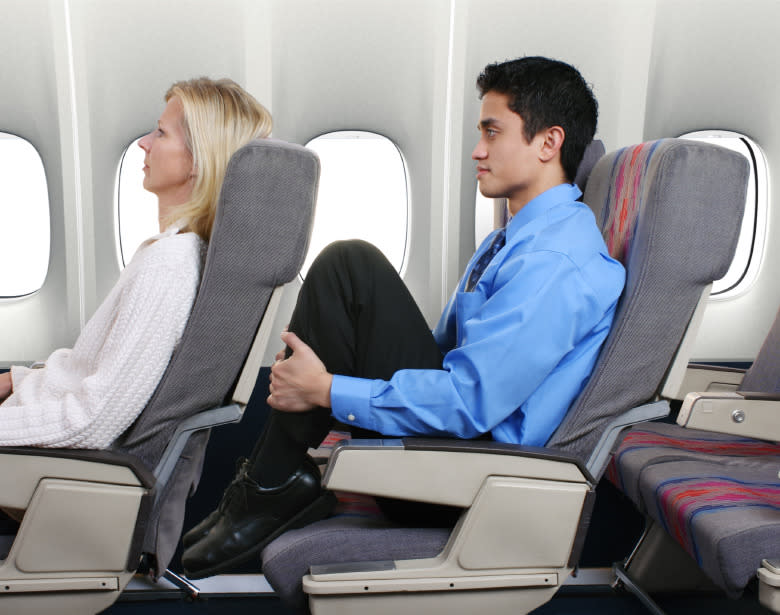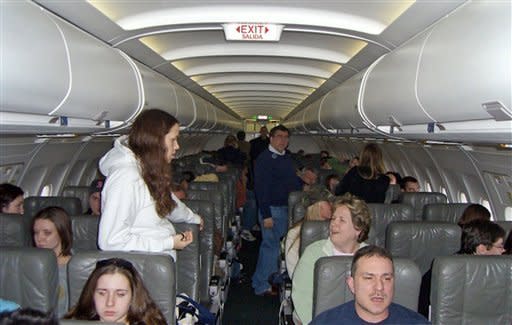Cramped Airplane Seats: Are Airlines Violating Our Human Rights?

Planes are more tightly packed than ever. Are our human rights being violated? (Illustration: iStock)
It’s the newest civil rights movement — or, more accurately, civil aviation rights movement.
As airlines look to boost passenger capacity, and profits, by reducing the legroom passengers enjoy on flights, some passenger rights groups are getting fed up. They say the increasingly cramped conditions airline passengers (especially those flying in economy class) face are no longer a consumer issue; they’re calling it a human rights issue.
“We have the right to a certain amount of space when we’re traveling,” Christopher Elliott tells Yahoo Travel. Elliott is a travel journalist and co-founder of the airline advocacy group Travelers United. He recently wrote an eyebrow-raising Washington Post op-ed about the new push for human rights on airplanes.
“After the Washington Post story, I heard from so many people who said, ‘I was on a flight and didn’t have any room,’” Elliott tells Yahoo Travel. “People are saying it’s about time someone said this because we don’t feel we’re being treated like people.”
Related: Cramping Your Style — Airplanes Are About to Get A Lot Smaller
Elliott notes that the average economy-class seat pitch, an airline industry measurement of passenger legroom, has declined over the years, from about 35 inches in the 1970s to about 31 inches today. Seat width has declined too, from around a high of 20 inches back in the 1980s to about 17-18 inches, according to USA Today.

Passenger rights groups want the government to regulate the minimum legroom airlines can give economy class passengers. (Photo: iStock)
“It’s an affront to our dignity as humans when we’re squeezed into an increasingly small space and told, 'You can have a little more space if you pay a lot more,’” Elliott says. “The government has said even animals in airplane cargo holds have the right to certain amount of space.” He feels human passengers should have similar protection.
WATCH: Travel Tips | How to Turn Coach into First Class
Elliott says this isn’t just a comfort issue. He’s talked to passenger advocates who believe cramped airline seating is a safety issue as well; the more people jammed into an airplane, the thinking goes, the harder it is to evacuate everybody in the event of an emergency.
“The safety argument is the stronger argument [for increasing seat lengths],” says Elliott. “I think the human rights argument may be the more emotional one.”
Related: Worth the Splurge? An Airline-By-Airline Guide to Premium Economy
Of course, no one’s comparing your tight seat on your flight to Orlando to people suffering real human rights abuses throughout the world. And no one’s advocating hauling airline officials to the Hague to stand trial for crimes against humanity (however intriguing an idea that may be).
Instead, Elliott notes that consumer groups — including Travelers United and FlyersRights — want the government to expand the definition of the rights and legroom airplane passengers are entitled to. Elliott says there’s ample precedent for such a change.
"You have tenement laws in New York City passed at the end of the 19th century that said houses and apartments had to have a certain amount of rooms,” Elliott says. “Airplane seat [rules] wouldn’t be that much of a stretch.”
Related: What Could Be Worse Than Economy Class? Airline Reportedly Considering “Economy Minus”
And there’s recent airplane industry precedent. Just a few years ago, there seemed to be horror story after horror story of airplane passengers stuck on the tarmac for seven or eight hours with no food, water, or access to the bathroom as their planes waited to take off. Public outcry led the U.S. Department of Transportation to ban U.S.-based airlines operating domestic flights from leaving a plane on the tarmac for more than three hours (for carriers operating international flights, the limit is four hours).

These JetBlue passengers were stuck on the tarmac for hours in 2007, leading to a successful push for regulation. Will we see similar new rules for seat length? (Photo: AP)
“That was an emotional issue where people were trapped on planes,” says Elliott. “Now they’re trapped on seats.”
Elliott and passenger rights advocates want the DOT to act once again to require a minimum amount of leg room (Elliott backs about 35-36 inches).
“We can all agree those tarmac delay rules were good for passengers,” says Elliott. “I have no doubt these new rules would be good for passengers as well.”
Airlines, however, do have their doubts. As one might expect, they’re vehemently opposed to more government regulation of their already highly-regulated industry.
“The DOT’s own Advisory Committee for Aviation Consumer Protection just decided to not make a recommendation on seat sizes,” says Melanie Hinton, a spokesperson for the airline industry trade group Airlines for America, in an email to Yahoo Travel. “We also believe that government should not regulate, but instead market forces, which reflect consumer decisions, and competition should determine what is offered. Those offerings are one component of what drives competition and product differentiation among airlines. And as with any commercial product or service, customers vote every day with their wallet.”
That does bring up a point. As airlines have decreased legroom, their profits have increased, which shows that while passengers may complain about being cramped, they haven’t given airlines much incentive to change. If consumers don’t like the cramped seats offered by airlines in economy, can’t they just find another airline that offers more room? Or perhaps take the train?

Airlines say the market, not government, should regulate how much legroom airlines should give passengers. (Photo: iStock)
“That’s just wrong,” says Elliott. For one thing, there’s the obvious fact that passengers sometimes have no choice but to fly (as of yet, Amtrak doesn’t offer service to Hawaii). But he also says the notion of consumer choice is an illusion in the modern airline industry,
“With all the recent airline mergers and code sharing alliances [between airlines] you realize that if you’re flying across the Atlantic you only have a couple of options,” Elliott says. “We all know something is wrong here and no amount of airline rhetoric can change that.”
While airline rhetoric may not change anything, Elliott thinks this new consumer push may not make any changes either. “Right now the stars are not aligned politically for anything to happen,” he says. He believes it’ll take nothing short of a tragedy to force change in this area: perhaps a rash of fatal blood clots in passengers being immobilized in tight seats for long flights. Or people dying in a plane emergency because the plane was too cramped to be evacuated easily.
“It shouldn’t have to come to this: you shouldn’t have to have people dying,” Elliott says. “This is very reasonable regulation. People know that when they’re seated in a cramped seat, that’s an affront to their dignity.”
WATCH: A Broad Abroad — Schooling The Food King, Eric Ripert, In Puerto Rico
Let Yahoo Travel inspire you every day. Hang out with us on Facebook,Twitter, Instagram, and Pinterest. Check out our original adventure travel series A Broad Abroad.

